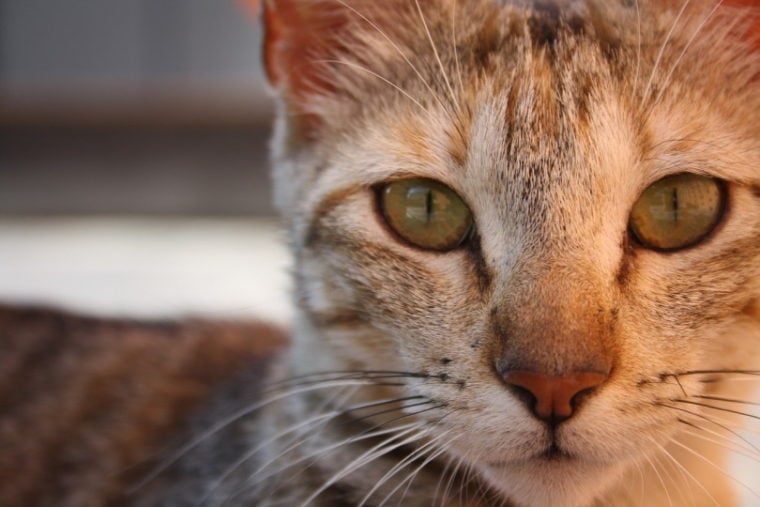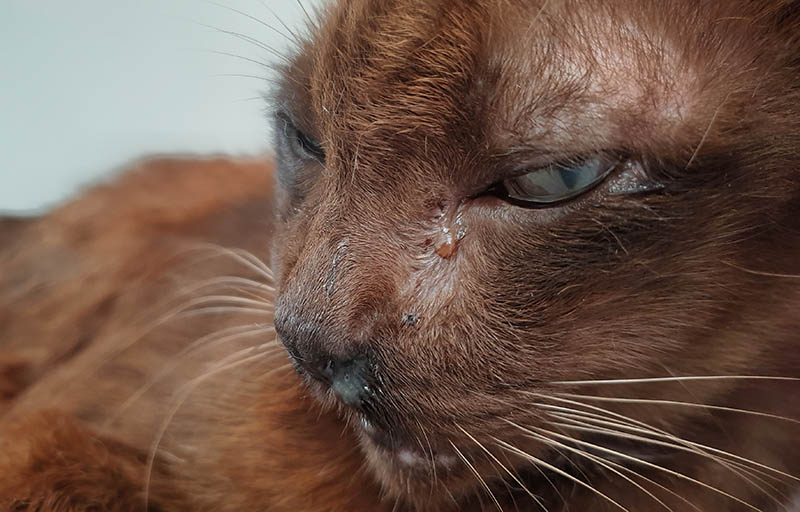
If your adorable cat is suddenly sporting some not-so-cute eye boogers, you might wonder what’s causing the extra gunk. Cat eye discharge can have a variety of causes, including medical conditions or breed-related facial structure abnormalities.
There are a variety of conditions that can cause cats to develop those pesky eye boogers and this type of condition is called Eye Discharge. In this article, we’ll explain what exactly cat eye discharge is and cover some of the most common reasons it occurs. We’ll also let you know how to keep your cat’s eyes booger-free and how to know when it’s time to head to the vet.
What Is Cat Eye Discharge?
Cat eye discharge is any extra substance that comes from your cat’s eyes. Like humans, cats produce tears to keep their eyes lubricated but normally, this liquid stays in their eyes.
Cat eye discharge could look like excess tears leaking out. It could also be a thicker, mucus-like consistency. The color may be yellow, green, or dark.
Possible Causes of Cat Eye Discharge
So, what’s causing your cat’s eye boogers? Here are some of the most common conditions that could cause eye discharge.

1. Dry Eye
Dry eye is a condition where the cat doesn’t produce enough tears, causing the eye’s surface to become dry and irritated. If your cat has the condition, their eye discharge may look thick and yellow.
2. Uveitis
Uveitis, a condition where the inside structures of the cat’s eyes are inflamed, usually occurs as a side effect of another condition such as infections, cancer, or immune system problems. Eye discharge is just one of the symptoms of uveitis
3. Eyelid Abnormalities
Entropion and ectropion are two inherited eyelid conditions that may cause eye discharge. With entropion, the eyelid rolls inward, bringing the eyelashes into contact with the eye surface. Ectropion is the opposite problem, a rolled-out eyelid that leaves the eye unprotected and vulnerable to irritation.
4. Upper Respiratory Infection
Your cat’s eye discharge could be caused by an upper respiratory infection. Typically, upper respiratory infections are caused by a virus, such as herpes, and are extremely contagious. You may also notice sneezing and nasal discharge with this condition.
5. Corneal Ulcer
An injury to the surface of your cat’s eye called a corneal ulcer, is another common cause of eye discharge. You may notice excessive tearing or colored discharge if the ulcer becomes infected.
6. Blocked Tear Ducts
The excess tears your cat produces are supposed to drain away into the tear ducts located at the corners of their eyes. However, tear ducts can become blocked, causing the tears to discharge from the eyes instead.
Tear ducts can become blocked due to hair or debris. Some flat-faced cat breeds are born with blocked or narrowed tear ducts due to their facial shape. Himalayans and Persians often have this condition, for example.
7. Eye Infections
Conjunctivitis or an eye infection is one of the most common causes of eye discharge in cats. Eye discharge may be colored or clear. Eye infections often occur secondary to herpes infection or allergies.
When Should You Worry About Cat’s Eye Discharge
As you can see, eye boogers have many causes. So how do you know when eye discharge is a cause for concern?
Because eyes are so delicate, any condition impacting them should be taken seriously and treated quickly. Besides discharge, here are some other signs to look for indicating your cat may have an eye problem:
Many eye conditions are extremely painful and can quickly progress to the point that the cat’s vision may be threatened. In addition, some eye conditions occur as a side effect of diseases impacting the cat’s whole body, such as immune system disorders or fungal infections.
Most eye problems require veterinary treatment and some can only be controlled, not cured. Eye drops or ointments are often prescribed and some conditions, such as dry eye, require long-term medications.
For some eye issues–such as eyelid abnormalities or blocked tear ducts–surgery may be required to correct the problem. If your vet feels your cat’s eye condition requires more specialized care, they may refer you to a veterinary ophthalmologist.
Cleaning Your Cat’s Eye Boogers
If your cat is squinting or showing any signs of a painful eye, don’t attempt to clean their eye boogers before consulting your veterinarian.
Once you have the all-clear, cleaning up eye discharge is a fairly simple process. You’ll only need warm water and a soft cloth, cotton ball, or gauze.
Soak the cleaning material in warm water and carefully wipe your cat’s eyes. Start in the inside corner of the eye and wipe down and away from the eye. Be careful not to touch the surface of your cat’s eye as you clean.
Use a separate cleaning material to clean each eye, especially if your cat has an infection. This will help prevent bacteria or other contaminants from spreading between the eyes.
If your vet asks you to clean your cat’s eyes as part of their treatment protocol, make sure you clean them before administering eye medications. If not, you may accidentally remove some of the ointment or drops you just placed in your cat’s eyes.

Conclusion
While eye boogers may be a fairly common occurrence in cats, especially certain breeds, they shouldn’t be considered normal. Have it checked out by a vet if the discharge doesn’t clear up within about a day or if you notice any of the other, more concerning signs that we mentioned.
Featured Image Credit: enrikap, Pixabay








